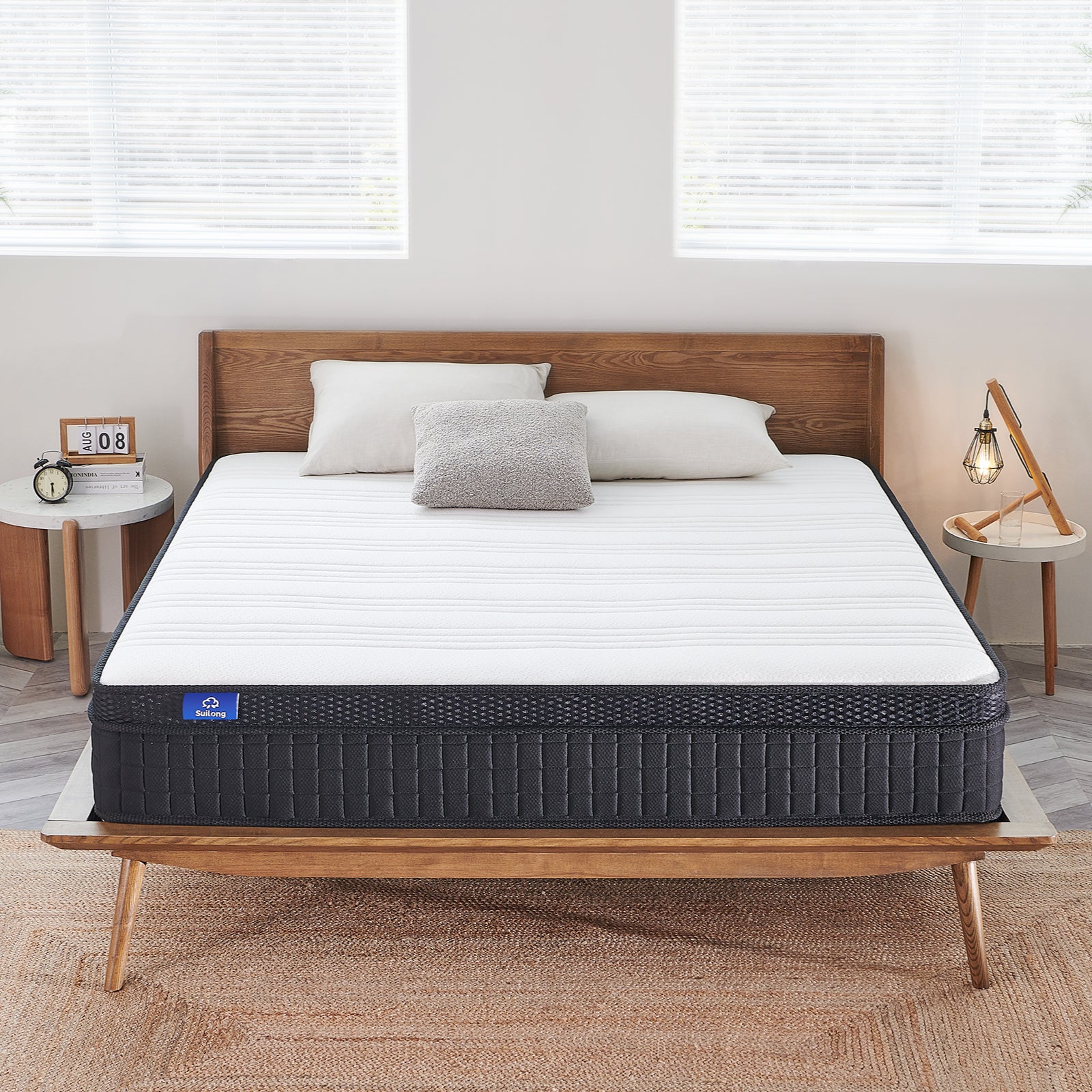What Is The Healthiest Position To Sleep In?

Discover the healthiest sleep positions and how they impact your well-being. Explore expert insights on side, back, and stomach sleeping to enhance your sleep quality and overall health. Ideal for anyone seeking a restful night.
1. overview of sleep positions: what are our options?
1.1 Sleeping on your back: pros and cons
As an expert in the mattress manufacturing industry, I am often asked: what is the healthiest sleep position? Let's start with supine sleep. When you lie on your back, your body weight is evenly distributed, taking pressure off your back and neck. This is a boon for those who experience frequent back pain. However, it is also important to note that if the pillow is too high or too low, it may lead to neck discomfort. Also, sleeping on your back may aggravate snoring and sleep apnoea. Therefore, choosing the right pillow and mattress memory foam mattress is crucial.
1.2 Side sleeping: the difference between left and right sides
Side-sleeping is another common sleeping position, and it's a better option, especially for pregnant women and those suffering from acid reflux. Sleeping on the left side aids digestion and can reduce the symptoms of acid reflux. Sleeping on the left side is also a better option for heart health as it helps with blood circulation. However, sleeping on your side for long periods of time can put pressure on your shoulders and hips, so it's important to choose a high-quality mattress to provide proper support.
1.3 Prone sleeping: how does it affect our body?
Sleeping in a prone position may not be the best option as it tends to put a strain on the neck and spine. In prone sleeping, the head usually needs to be turned to the side in order to breathe, which can lead to twisting of the neck. In addition, this position can also increase stress on the back. I recommend avoiding this position or using specially designed pillows and mattresses like mattress in a box to minimise its adverse effects on the body.
2. Understand the health effects of different sleeping positions
2.1 What positions may be detrimental to the body?
In my professional experience, some sleeping positions may lead to long-term health problems. For example, prolonged prone sleeping increases pressure on the back and neck, which may lead to chronic pain. Pillows that are too high or too low, either in the supine or side sleep position, can lead to neck discomfort. To maintain the natural curve of the spine, I recommend choosing the right pillow height and a supportive mattress.
2.2 How to sleep properly for good health?
The correct sleeping position should maintain the natural curve of the spine. I recommend that back sleepers choose a pillow that is not too high but provides enough support to keep the neck and head aligned. Side sleepers, on the other hand, should choose a pillow that fills the space between their head and the mattress to avoid bending the neck. In addition, a good mattress such as the king size mattress and box spring is essential to keep the entire body supported and comfortable.
2.3 Special consideration: impact on heart health and blood flow
Different sleeping positions have different effects on heart health and blood flow. Sleeping on the back may not be suitable for people with heart disease, as this position may aggravate the heart. Side sleeping, especially on the left side, is often considered more beneficial to the heart because it promotes better blood circulation. However, an individual's specific health conditions and needs may vary, so it's important to consult your doctor before adjusting your sleeping position to improve your heart health.
Read on in the next section to find out why sleeping on your side is good for your heart health and whether sleeping on your left or right side is better for your heart.
3. In-Depth Analysis: The Heart Benefits of Side Sleeping
3.1 Why is side sleeping good for your heart?
Sleeping on your side, especially on your left side, has significant heart health benefits. Sleeping on the left side reduces stress on the heart, as this position helps gravity improve blood circulation. In addition, sleeping on the left side is also beneficial in reducing acid reflux, which indirectly reduces the burden on the heart. It is important to note that a high quality mattress can provide better support and comfort for side sleepers.
3.2 Left-side or right-side sleep: which is better?
From a heart-health perspective, sleeping on the left side is often considered superior to sleeping on the right side. This is because sleeping on the left side helps to improve blood flow to the heart, whereas sleeping on the right side can put extra strain on the heart. Of course, this doesn't mean that sleeping on the right side is completely detrimental to your health, but for people with heart disease or those looking to optimise their heart health, sleeping on the left side is the better option.
3.3 How can I improve my heart's circulation through my sleeping position?
In order to improve blood circulation to the heart through your sleeping position, in addition to choosing to sleep on your left side, you should also pay attention to your choice of mattress and pillow. A mattress that provides good support and comfort can help maintain the correct sleeping position, while a pillow of the right height can help keep the head and spine aligned, which in turn promotes blood flow.
Follow along as I explore how mattresses and pillows affect sleep posture and how you can optimise your sleep environment to improve overall sleep quality.
4. Healthy Sleep from a Different Perspective: Other Important Factors
4.1 The impact of mattress and pillow choice on sleep posture
As an expert in the mattress manufacturing industry, I understand the importance of choosing the right mattress and pillow to maintain a healthy sleeping position. A good quality mattress not only provides the necessary support, but also adjusts to your sleeping position to maintain the natural curve of your spine. It's also important to choose the right height and firmness of pillow for your sleeping position. This helps to reduce pressure on your neck and shoulders, thus improving the quality of your sleep.
4.2 Importance of Sleep Environment
Apart from the mattress and pillow, other aspects of the sleep environment also have a significant impact on the quality of sleep. A quiet, dark and cool sleep environment helps to improve sleep quality. Consider using blackout curtains, earplugs or white noise machines to create the ideal sleep environment. It is also important to maintain the right room temperature and proper humidity.
4.3 Bedtime Habits: How to Prepare for a Good Night's Sleep
Good bedtime habits are key to getting quality sleep. Avoid caffeine and alcohol before bedtime as they may interfere with sleep. Also, creating a relaxing bedtime ritual, such as reading or meditating, can help you fall asleep faster. Also, try to minimise the amount of time you spend using electronic devices before bed to avoid blue light disrupting your sleep cycle.
Keep reading the next section to learn why it's so important to find the best sleeping position for you and how small changes can make a big difference. We'll also invite you to share your own sleep experiences to learn and grow together.
5. Finding the Best Sleeping Position for You
5.1 What is the healthiest sleeping position?
After an in-depth discussion, we can see that there is no one-size-fits-all best sleeping position. Everyone has different health conditions and preferences, so the healthiest sleeping position depends on the specific needs of the individual. It's important to pay attention to your body's signals, and if a certain sleeping position makes you feel uncomfortable, you may need to make adjustments. Also, the right mattress and pillow are essential to maintaining a healthy sleeping position.
5.2 Inviting readers to share and interact
I invite you to share your own sleep experiences in the comments section. How did you find the best sleeping position for you? Have you tried changing your sleeping position to address certain health issues? Your experience could be very helpful to others.
5.3 Keep exploring and improving
On the journey to finding the best sleeping position, it is important to remain open and willing to experiment. Remember that sleep quality is a continuous process of improvement. Our bodies and health change over time, so it's important to adjust your sleeping position and sleep environment when appropriate.
Thank you for reading this article. I hope you have gained valuable information from it and found inspiration to improve your sleep quality. Remember, a good night's sleep is the cornerstone of a healthy life, and it pays to invest in a quality mattress and pillow. Have a great night's sleep tonight!
FAQs
Q1: What are the main benefits of sleeping on your back?
A1: Sleeping on your back evenly distributes weight, reducing pressure on the spine and neck. However, it might exacerbate snoring and sleep apnea in some people.
Q2: How does sleeping on your side affect health?
A2: Side sleeping, especially on the left side, aids digestion and reduces acid reflux. It's also beneficial for heart health due to improved circulation.
Q3: Why is stomach sleeping generally not recommended?
A3: Stomach sleeping can strain your neck and back since it often requires turning the head to one side. It's better to sleep on your back or side for spinal alignment.
Q4: What sleeping position is best for heart health?
A4: Sleeping on your left side is considered best for heart health. It reduces the pressure on your heart and promotes better circulation.
Q5: How does the choice of mattress and pillow affect sleep quality?
A5: The right mattress and pillow provide necessary support and maintain spinal alignment. Memory foam mattresses and pillows can adapt to your body's shape for optimal comfort.
Q6: What sleep environment is ideal for good quality sleep?
A6: A quiet, dark, and cool environment is ideal. Consider blackout curtains, earplugs, or white noise machines, and maintain a comfortable room temperature.
Q7: What are good sleep habits to improve sleep quality?
A7: Avoid caffeine and alcohol before bed, establish a relaxing bedtime routine, and reduce electronic device usage to minimize blue light exposure.
Q8: Is it okay to switch sleeping positions during the night?
A8: Yes, it's normal to change positions during sleep. The key is to start in a position that supports spinal alignment and comfort.
Q9: Can changing my sleep position help with back pain?
A9: Yes, adjusting your sleep position can alleviate back pain. Sleeping on your back or side with proper support from your mattress and pillow can help.
Q10: Are special pillows or mattresses needed for optimal sleep?
A10: While not mandatory, ergonomic pillows and mattresses like memory foam can enhance sleep quality by providing better support and adapting to your body.


















